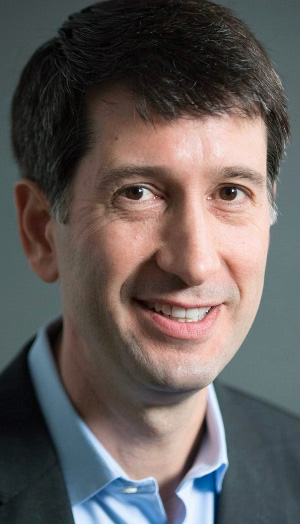

 I feel incredibly lucky to work every day with some of the biggest, most recognised and most innovative organisations from around the world on developing strategies for their .brand TLDs. In this capacity, I also have the privilege to meet some of the most knowledgeable and forward-thinking experts in branding, digital marketing, web development and technology, to name a few. One such person is the brilliantly talented Matt Dorville. more
I feel incredibly lucky to work every day with some of the biggest, most recognised and most innovative organisations from around the world on developing strategies for their .brand TLDs. In this capacity, I also have the privilege to meet some of the most knowledgeable and forward-thinking experts in branding, digital marketing, web development and technology, to name a few. One such person is the brilliantly talented Matt Dorville. more
 The other day several of us were gathered in a conference room on the 17th floor of the LinkedIn building in San Francisco, looking out of the windows as we discussed some various technical matters. All around us, there were new buildings under construction, with that tall towering crane anchored to the building in several places. We wondered how that crane was built, and considered how precise the building process seemed to be to the complete mess building a network seems to be. more
The other day several of us were gathered in a conference room on the 17th floor of the LinkedIn building in San Francisco, looking out of the windows as we discussed some various technical matters. All around us, there were new buildings under construction, with that tall towering crane anchored to the building in several places. We wondered how that crane was built, and considered how precise the building process seemed to be to the complete mess building a network seems to be. more
 The incredible pace of change of the Internet -- from research laboratory inception to global telecommunication necessity -- is due to the continuing pursuit, development and deployment of technology and practices adopted to make the Internet better. This has required continuous attention to a wide variety of problems ranging from "simple" to so-called "wicked problems". Problems in the latter category have been addressed through collaboration. This post outlines key characteristics of successful collaboration activities. more
The incredible pace of change of the Internet -- from research laboratory inception to global telecommunication necessity -- is due to the continuing pursuit, development and deployment of technology and practices adopted to make the Internet better. This has required continuous attention to a wide variety of problems ranging from "simple" to so-called "wicked problems". Problems in the latter category have been addressed through collaboration. This post outlines key characteristics of successful collaboration activities. more
 The Bug Bounty movement grew out a desire to recognize independent security researcher efforts in finding and disclosing bugs to the vendor. Over time the movement split into those that demanded to be compensated for the bugs they found and third-party organizations that sought to capitalize on intercepting knowledge of bugs before alerting the vulnerable vendor. Today, on a different front, new businesses have sprouted to manage bug bounties on behalf of a growing number of organizations new to the vulnerability disclosure space. more
The Bug Bounty movement grew out a desire to recognize independent security researcher efforts in finding and disclosing bugs to the vendor. Over time the movement split into those that demanded to be compensated for the bugs they found and third-party organizations that sought to capitalize on intercepting knowledge of bugs before alerting the vulnerable vendor. Today, on a different front, new businesses have sprouted to manage bug bounties on behalf of a growing number of organizations new to the vulnerability disclosure space. more
 The Best Practice Forum (BPF) on IPv6 at the Internet Governance Forum (IGF) explored what economic and commercial incentives drive providers, companies and organizations to deploy IPv6 on their networks and for their services. The BPF collected case studies, held open discussions online and at the 2016 IGF meeting, and produced a comprehensive output report. This article gives a high-level overview. more
The Best Practice Forum (BPF) on IPv6 at the Internet Governance Forum (IGF) explored what economic and commercial incentives drive providers, companies and organizations to deploy IPv6 on their networks and for their services. The BPF collected case studies, held open discussions online and at the 2016 IGF meeting, and produced a comprehensive output report. This article gives a high-level overview. more
 Let's be clear: right now, any statements on when (or even if) a follow-up round of new gTLD applications might happen are pure conjecture. The first round closed on April 12, 2012. Since then, the pressure has been increasing for ICANN to actually live up to the guidebook premise of launching "subsequent gTLD application rounds as quickly as possible" with "the next application round to begin within one year of the close of the application submission period for the initial round." But that deadline is clearly not going to be met. more
Let's be clear: right now, any statements on when (or even if) a follow-up round of new gTLD applications might happen are pure conjecture. The first round closed on April 12, 2012. Since then, the pressure has been increasing for ICANN to actually live up to the guidebook premise of launching "subsequent gTLD application rounds as quickly as possible" with "the next application round to begin within one year of the close of the application submission period for the initial round." But that deadline is clearly not going to be met. more
 The emergence and proliferation of Internet of Things (IoT) devices on industrial, enterprise, and home networks brings with it unprecedented risk. The potential magnitude of this risk was made concrete in October 2016, when insecure Internet-connected cameras launched a distributed denial of service (DDoS) attack on Dyn, a provider of DNS service for many large online service providers (e.g., Twitter, Reddit). Although this incident caused large-scale disruption, it is noteworthy that the attack involved only a few hundred thousand endpoints... more
The emergence and proliferation of Internet of Things (IoT) devices on industrial, enterprise, and home networks brings with it unprecedented risk. The potential magnitude of this risk was made concrete in October 2016, when insecure Internet-connected cameras launched a distributed denial of service (DDoS) attack on Dyn, a provider of DNS service for many large online service providers (e.g., Twitter, Reddit). Although this incident caused large-scale disruption, it is noteworthy that the attack involved only a few hundred thousand endpoints... more
 Admittedly, timing is not altogether "all" since there's a palette of factors that go into deciding unlawful registrations of domain names, and a decision as to whether a registrant is cybersquatting or a mark owner overreaching, is likely to include a number of them, but timing is nevertheless fundamental in determining the outcome. Was the mark in existence before the domain name was registered? Is complainant relying on an unregistered mark? What was complainant's reputation when the domain name was registered? What proof does complainant have that registrant had knowledge of its mark? Simply to have a mark is not conclusive of a right to the domain name. more
Admittedly, timing is not altogether "all" since there's a palette of factors that go into deciding unlawful registrations of domain names, and a decision as to whether a registrant is cybersquatting or a mark owner overreaching, is likely to include a number of them, but timing is nevertheless fundamental in determining the outcome. Was the mark in existence before the domain name was registered? Is complainant relying on an unregistered mark? What was complainant's reputation when the domain name was registered? What proof does complainant have that registrant had knowledge of its mark? Simply to have a mark is not conclusive of a right to the domain name. more
 The choices for consumers and business in Europe to get themselves online have never been so great. Social media, apps and blogsites all have made a lasting impression, and we are now in an increasingly crowded market with the addition of hundreds of new gTLDs. So how has all this affected growth and market shares among domain names in Europe? more
The choices for consumers and business in Europe to get themselves online have never been so great. Social media, apps and blogsites all have made a lasting impression, and we are now in an increasingly crowded market with the addition of hundreds of new gTLDs. So how has all this affected growth and market shares among domain names in Europe? more
 A proposal from the Domain Name Association (DNA) would provide copyright owners with a new tool to fight online infringement -- but the idea is, like other efforts to protect intellectual property rights on the Internet, proving controversial. The proposed Copyright Alternative Dispute Resolution Policy is one of four parts of the DNA's "Healthy Domains Initiative" (HDI). more
A proposal from the Domain Name Association (DNA) would provide copyright owners with a new tool to fight online infringement -- but the idea is, like other efforts to protect intellectual property rights on the Internet, proving controversial. The proposed Copyright Alternative Dispute Resolution Policy is one of four parts of the DNA's "Healthy Domains Initiative" (HDI). more
Nomulus is the code for the backend domain name registry solution offered by Google which requires the use of Google Cloud. This solution is the one used for all of Google's new gTLDs and the solution works. An announcement for this solution can look like a potentially "simple" solution for future .BRAND new gTLD applicants, but is it truly the case? more
 Let's be honest about it. Nobody -- including those very clever people that were present at its birth -- had the slightest idea what impact the internet would have in only a few decades after its invention. The internet has now penetrated every single element of our society and of our economy, and if we look at how complex, varied and historically different our societies are, it is no wonder that we are running into serious problems with the current version of our internet. more
Let's be honest about it. Nobody -- including those very clever people that were present at its birth -- had the slightest idea what impact the internet would have in only a few decades after its invention. The internet has now penetrated every single element of our society and of our economy, and if we look at how complex, varied and historically different our societies are, it is no wonder that we are running into serious problems with the current version of our internet. more
 A stack contrast is emerging within the DNS between providers who tolerate blatantly illegal domain use and those who do not. Our study, just published here focuses on five U.S.-based providers, their policies, and their response to reports of opioid traffic within their registry or registrar. There are many providers, not covered here, who removed hundreds of domains selling opioids and I applaud their efforts. more
A stack contrast is emerging within the DNS between providers who tolerate blatantly illegal domain use and those who do not. Our study, just published here focuses on five U.S.-based providers, their policies, and their response to reports of opioid traffic within their registry or registrar. There are many providers, not covered here, who removed hundreds of domains selling opioids and I applaud their efforts. more
 The Internet is a great success and an abject failure. We need a new and better one. Let me explain why. We are about to enter an era when online services are about to become embedded into pretty much every activity in life. We will become extremely dependent on the safe and secure functioning of the underlying infrastructure. Whole new industries are waiting to be born as intelligent machines, widespread robotics, and miniaturized sensors are everywhere. more
The Internet is a great success and an abject failure. We need a new and better one. Let me explain why. We are about to enter an era when online services are about to become embedded into pretty much every activity in life. We will become extremely dependent on the safe and secure functioning of the underlying infrastructure. Whole new industries are waiting to be born as intelligent machines, widespread robotics, and miniaturized sensors are everywhere. more
 Few parts of the Domain Name System are filled with such levels of mythology as its root server system. Here I'd like to try and explain what it is all about and ask the question whether the system we have is still adequate, or if it's time to think about some further changes. The namespace of the DNS is a hierarchically structured label space. Each label can have an arbitrary number of immediately descendant labels, and only one immediate parent label. more
Few parts of the Domain Name System are filled with such levels of mythology as its root server system. Here I'd like to try and explain what it is all about and ask the question whether the system we have is still adequate, or if it's time to think about some further changes. The namespace of the DNS is a hierarchically structured label space. Each label can have an arbitrary number of immediately descendant labels, and only one immediate parent label. more
Sponsored byIPv4.Global

Sponsored byVerisign

Sponsored byRadix

Sponsored byVerisign

Sponsored byCSC

Sponsored byDNIB.com

Sponsored byWhoisXML API
